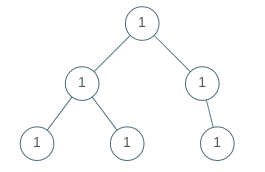965. Univalued Binary Tree
A binary tree is univalued if every node in the tree has the same value.
Return true if and only if the given tree is univalued.
Example 1:

Input: [1,1,1,1,1,null,1]
Output: true
Example 2:

Input: [2,2,2,5,2]
Output: false
Note:
- The number of nodes in the given tree will be in the range
[1, 100]. - Each node's value will be an integer in the range
[0, 99].
Code:
/**
* Definition for a binary tree node.
* struct TreeNode {
* int val;
* TreeNode *left;
* TreeNode *right;
* TreeNode(int x) : val(x), left(NULL), right(NULL) {}
* };
*/
class Solution {
public:
bool isUnivalTree(TreeNode* root) {
solve(root, root->val);
return ans;
}
void solve(TreeNode* root, int num) {
if (root->val != num) ans = false;
if (root->left != NULL) solve(root->left, num);
if (root->right != NULL) solve(root->right, num);
}
private:
bool ans = true;
};
967. Numbers With Same Consecutive Differences
Return all non-negative integers of length N such that the absolute difference between every two consecutive digits is K.
Note that every number in the answer must not have leading zeros except for the number 0 itself. For example, 01 has one leading zero and is invalid, but 0 is valid.
You may return the answer in any order.
Example 1:
Input: N = 3, K = 7
Output: [181,292,707,818,929]
Explanation: Note that 070 is not a valid number, because it has leading zeroes.
Example 2:
Input: N = 2, K = 1
Output: [10,12,21,23,32,34,43,45,54,56,65,67,76,78,87,89,98]
Code:
class Solution {
public:
vector<int> numsSameConsecDiff(int N, int K) {
vector<int> ans;
if (N == 1) {
for (int i = 0; i < 10; ++i)
ans.push_back(i);
return ans;
}
for (int i = 1; i < 10; ++i) {
string s = to_string(i);
dfs(s, N, K, ans);
}
return ans;
}
void dfs(string s, const int N, const int K, vector<int>& ans) {
if (s.length() == N) {
ans.push_back(stoi(s));
return ;
}
int lastNum = s[s.length()-1] - '0';
int temp = lastNum + K;
string dummy = s;
if (temp >= 0 && temp < 10) {
dummy += to_string(temp);
dfs(dummy, N, K, ans);
}
if (K != 0) {
int temp = lastNum - K;
if (temp >= 0 && temp < 10) {
s += to_string(temp);
dfs(s, N, K, ans);
}
}
}
};